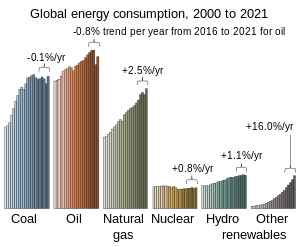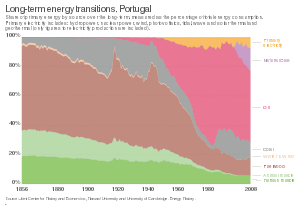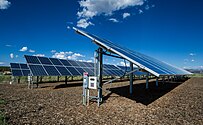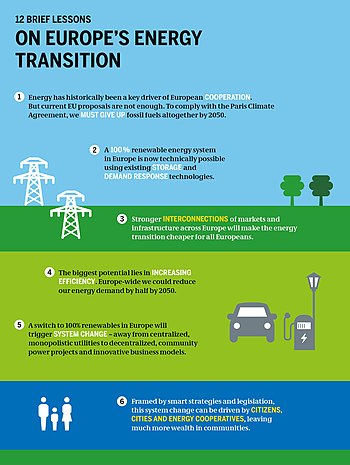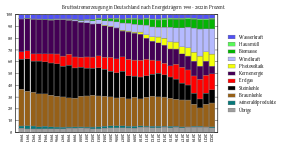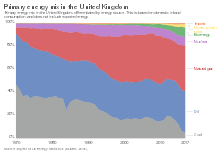From Wikipedia, the free encyclopedia
Coal, oil, and natural gas remain the primary global energy sources even as
renewables have begun rapidly increasing.
The energy transition is the ongoing process of replacing fossil fuels with low carbon energy sources. More generally, an energy transition is a significant structural change in an energy system regarding supply and consumption.
The industrial revolution was driven by an energy transition from wood and other biomass to coal, followed by oil and most recently natural gas. Historically, there is a correlation between an increasing demand for energy and availability of different energy sources.
The current transition to sustainable energy differs as it is largely driven by a recognition that global greenhouse-gas emissions must be brought to zero. Since fossil fuels are the largest single source of carbon emissions, the quantity that can be produced is limited by the Paris Agreement
of 2015 to keep global warming below 1.5 °C. Over 70% of our global
greenhouse gas emissions result from the energy sector, for transport,
heating, and industrial use.
Wind power and solar photovoltaic systems (PV) have the greatest potential to mitigate climate change. Since the late 2010s, the renewable energy transition is also driven by the rapidly increasing competitiveness of both. Another motivation for the transition is to limit other environmental impact of the energy industry.
The renewable energy transition includes a shift from internal combustion engine powered vehicles to more public transport, reduced air travel and electric vehicles. Electrification also regards the buildings sector, with heat pumps as the most efficient technology by far. For electrical grid scale flexibility, energy storage and super grids are vital to allow for variable, weather-dependent technologies.
Definition
An energy transition designates a significant change for an energy system related to resources, system structure, scale, economics, end use behaviour and energy policy.
A prime example is the change from a pre-industrial system relying on
traditional biomass, wind, water and muscle power to an industrial
system characterized by pervasive mechanization, steam power and the use
of coal.
After the 1973 oil crisis,
the term was coined by politicians and media. It was popularised by US
President Jimmy Carter in his 1977 Address on the Nation on Energy,
calling to "look back into history to understand our energy problem.
Twice in the last several hundred years, there has been a transition in
the way people use energy ... Because we are now running out of gas and oil, we must prepare quickly for a third change--to strict conservation and to the renewed use of coal and to permanent renewable energy sources like solar power."
The term was later globalised after the 1979 second oil shock, during
the 1981 United Nations in Nairobi on new and renewable sources of
energy.
From the 1990s, debates on energy transition have increasingly taken climate change mitigation into account. Since the adoption of the COP21 Paris Agreement in 2015, all 196 participating parties have agreed to reach carbon neutrality
by mid-century. Parties to the agreement committed "to limit global
warming to "well below 2 °C, preferably 1.5 °C compared to
pre-industrial levels". This requires a rapid energy transition with a downshift of fossil fuel production to stay within the carbon emissions budget.
In this context, the term 'energy transition' encompasses a reorientation of energy policy. This could imply a shift from centralized to distributed generation. It also includes attempts to replace overproduction and avoidable energy consumption with energy-saving measures and increased efficiency. In a broader sense the energy transition could also entail a democratization of energy.
History of energy transitions and energy additions
An example of a long-term historic energy transition: share of primary energy by source in Portugal
Historic approaches to past energy transitions are shaped by two main
discourses. One argues that humankind experienced several energy
transitions in its past, while the other suggests the term "energy
additions" as better reflecting the changes in global energy supply in
the last three centuries.
The chronologically first discourse was most broadly described by Vaclav Smil.
It underlines the change in the energy mix of countries and the global
economy. By looking at data in percentages of the primary energy source
used in a given context, it paints a picture of the world's energy
systems as having changed significantly over time, going from biomass to
coal, to oil, and now a mix of mostly coal, oil and natural gas. Until
the 1950s, the economic mechanism behind energy systems was local rather
than global.
The second discourse was most broadly described by Jean-Baptiste Fressoz.
It emphasises that the term "energy transition" was first used by
politicians, not historians, to describe a goal to achieve in the future
– not as a concept to analyse past trends. When looking at the sheer
amount of energy being used by humankind, the picture is one of an
ever-increasing energy consumption that is met by an ever-increasing
consumption of all the main energy sources available to humankind.
For instance, the increased use of coal in the 19th century indeed did
not replace wood consumption, but came on top of increased wood
consumption. Another example is the deployment of passenger cars in the
20th century. This evolution triggered an increase in both oil
consumption (to drive the car) and coal consumption (to make the steel
needed for the car). In other words, according to this approach,
humankind never performed a single energy transition in its history but
performed several energy additions.
Contemporary energy transitions differ in terms of motivation and
objectives, drivers and governance. As development progressed,
different national systems became more and more integrated becoming the
large, international systems seen today. Historical changes of energy
systems have been extensively studied.
While historical energy changes were generally protracted affairs,
unfolding over many decades, this does not necessarily hold true for the
present energy transition, which is unfolding under very different
policy and technological conditions.
For current energy systems, many lessons can be learned from history.
The need for large amounts of firewood in early industrial processes in
combination with prohibitive costs for overland transportation led to a
scarcity of accessible (e.g. affordable) wood and it has been found
that eighteenth century glass-works "operated like a forest clearing
enterprise".
When Britain had to resort to coal after largely having run out of
wood, the resulting fuel crisis triggered a chain of events that two
centuries later culminated in the Industrial Revolution.
Similarly, increased use of peat and coal were vital elements paving
the way for the Dutch Golden Age, roughly spanning the entire 17th
century. Another example where resource depletion triggered technological innovation and a shift to new energy sources in 19th Century whaling and how whale oil eventually became replaced by kerosene and other petroleum-derived products. With the success of a rapid energy transition it is also conceivable that there will be government buyouts or bailouts of coal mining regions.
Factors driving the low carbon energy transition
With
increasing implementation of renewable energy sources, costs have
declined, most notably for energy generated by solar panels.
Levelized cost of energy (LCOE) is a measure of the average net present cost of electricity generation for a generating plant over its lifetime.
A rapid energy transition to very-low or zero-carbon sources is required to mitigate the existential effects of climate change.
The rise in weather and climate extremes has already led to
irreversible impacts as natural and human systems are pushed beyond
their ability to adapt. Coal, oil and gas combustion account for 89% of CO2 emissions while they still provide 78% of primary energy consumption.
By 2050, burning coal must be reduced by 95%, oil by 60% and gas by 45%
compared to 2019 in order to achieve a 50% chance to meet the Paris Agreement target of limiting global heating to 1.5 °C. This refers to pathways with no or limited overshoot.
In spite of the knowledge about the risks of climate change since the 1980s and the vanishing carbon budget
for a 1.5 °C path, the global deployment of renewable energy could not
catch up with the increasing energy demand for many years.
Coal, oil and gas were cheaper. Only in countries with special tariffs
and subsidies, wind and solar power gained a considerable share, limited
to the power sector.
From 2010-2019, competitiveness of wind and solar power has
massively increased. Unit costs of solar energy dropped sharply by 85%,
wind energy by 55%, and lithium-ion batteries by 85%,
making wind and solar power the cheapest form for new installations in
many regions. Levelized costs for combined photovoltaics with storage
for a few hours are already lower than for gas peaking power plants. In 2021, the new electricity generating capacity of renewables exceeded 80% of all installed power.
Another important driver is energy security and independence, with increasing importance in Europe from the background of the 2022 Russian invasion of Ukraine.
The deployment of renewable energy can also include co-benefits of climate change mitigation:
positive socio-economic effects on employment, industrial development,
health and energy access. Depending on the country and the deployment
scenario, replacing coal power plants can more than double the number of
jobs per average MW capacity. In non-electrified rural areas, the deployment of solar mini-grids can significantly improve electricity access.
Employment opportunities by the green transition are associated with
the use of renewable energy sources or building activity for
infrastructure improvements and renovations. Additionally, the replacement of coal-based energy with renewables can lower the number of premature deaths caused by air pollution and reduce health costs.
Current technologies
Wind farm in Idaho, United States.
Photovoltaic array in Colorado.
Renewable energy
Global renewable energy capacity additions in 2020 included a 90% rise in global
wind capacity (green) and a 23% expansion of new
photovoltaic installations (yellow).
Companies,
governments and households committed $501.3 billion to decarbonization
in 2020, including solar, wind, electric vehicles, charging
infrastructure, storage, heating systems, CCS and hydrogen.
The energy sources that are considered the most important in the low carbon energy transition are wind power and solar power. Both offer the potential to reduce net emissions by 4 Gt CO2 equivalents per year each, half of it with lower net lifetime costs than the reference.
By 2022, hydroelectricity is the largest source of renewable electricity in the world, providing 16% of the world's total electricity in 2019.
However, because of its heavy dependence on geography and the generally
high environmental and social impact of hydroelectric power plants, the
growth potential of this technology is limited. Wind and solar power
are considered more scalable, but still require vast quantities of land
and materials. They have higher potential for growth.
These sources have grown nearly exponentially in recent decades thanks
to rapidly decreasing costs. In 2019, wind power supplied 5.3% worldwide
electricity while solar power supplied 2.6%.
While production from most types of hydropower plants can be
actively controlled, production from wind and solar power depends on the
weather. Electrical grids must be extended and adjusted to avoid wastage. Hydropower is therefore considered a dispatchable source, while solar and wind are variable renewable energy sources. These sources require dispatchable backup generation or energy storage
to provide continuous and reliable electricity. For this reason,
storage technologies also play a key role in the renewable energy
transition. As of 2020, the largest scale storage technology is pumped storage hydroelectricity, accounting for the great majority of energy storage capacity installed worldwide. Other important forms of energy storage are electric batteries and power to gas.
Other renewable energy sources include bioenergy, geothermal energy and tidal energy.
Regarding energy use and efficiency the electrification of road transport is one key technology.
Nuclear power
Timeline of commissioned and decommissioned nuclear capacity since the 1950s.
In the 1970s and 1980s, nuclear power gained a large share in some countries. In France and Slovakia more than half of the electrical power is still nuclear. It is regarded as a low carbon energy source
but comes with risks and increasing costs. Since the late 1990s,
deployment has slowed down. Decommissioning increases as many reactors
are close to the end of their lifetime. Germany has announced to stop its last three nuclear power plants by the end of 2022. On teh other hand, the China General Nuclear Power Group has articulated the goal of 200 GW by 2035, produced by 150 additional reactors.
Economic aspects
A shift in energy sources has the potential to redefine relations and
dependencies between countries, stakeholders and companies. Countries
or land owners with resources - fossil or renewable - face massive
losses or gains depending on the development of any energy transition.
In 2021, energy costs reached 13% of the global gross domestic product.
Global rivalries have contributed to the driving forces of the economics
behind the low carbon energy transition. Technological innovations
developed within a country have the potential to become an economic
force.
Social aspects
Influences
The energy transition discussion is heavily influenced by contributions from the oil industry. The oil industry controls the larger part of the world's energy supply and needs as petroleum continues to be the most accessible and available resource present today.
With a history of continued success and sustained demand, the oil
industry has become a stable aspect of society, the economy and the
energy sector. To transition to renewable energy technologies, the
government and economy must address the oil industry and its control of
the energy sector.
One way that oil companies are able to continue their work despite
growing environmental, social and economic concerns is through lobbying
efforts within local and national government systems. Lobbying
is defined as to conduct activities aimed at influencing public
officials and especially members of a legislative body on legislation
Historically, the fossil fuel lobby
has been highly successful in limiting regulations on the oil industry
and enabling business-as-usual techniques. From 1988 to 2005, Exxon Mobil,
one of the largest oil companies in the world, spent nearly $16 million
in anti-climate change lobbying and providing misleading information
about climate change to the general public. The oil industry acquires significant support through the existing banking and investment structure. By investing in the fossil fuel industry, it is provided with financial support to continue its business ventures. The concept that the industry should no longer be financially supported has led to the social movement known as divestment. Divestment
is defined as the removal of investment capital from stocks, bonds or
funds in oil, coal and gas companies for both moral and financial
reasons
Banks, investing firms, governments, universities, institutions
and businesses are all being challenged with this new moral argument
against their existing investments in the fossil fuel industry and many
such as Rockefeller Brothers Fund, the University of California, New
York City and more have begun making the shift to more sustainable,
eco-friendly investments.
Impacts
The low carbon energy transition has many benefits and challenges
that are associated with it. One of the positive social impacts that is
predicted is the use of local energy sources to provide stability and
economic stimulation to local communities.
Not only does this benefit local utilities through portfolio
diversification, but it also creates opportunities for energy trade
between communities, states and regions.
Additionally, energy security has been a struggle worldwide that has
led to many issues in the OPEC countries and beyond. Energy security is
evaluated by analyzing the accessibility, availability, sustainability,
regulatory and technological opportunity of our energy portfolio.
Renewable Energy presents an opportunity to increase our energy security
by becoming energy independent and have localized grids that decrease
energy risks geopolitically. In this sense, the benefits and positive outcomes of the renewable energy transition are profound.
There are also risks and negative impacts on society because of
the renewable energy transition that need to be mitigated. The coal
mining industry plays a large part in the existing energy portfolio and
is one of the biggest targets for climate change activists due to the
intense pollution and habitat disruption that it creates. The transition to renewable is expected to have decrease the need and viability of coal mining in the future.
This is a positive for climate change action, but can have severe
impacts on the communities that rely on this business. Coal mining
communities are considered vulnerable to the renewable energy
transition. Not only do these communities face energy poverty already, but they also face economic collapse when the coal mining businesses move elsewhere or disappear altogether.
These communities need to quickly transition to alternative forms of
work to support their families, but lack the resources and support to
invest in themselves. This broken system perpetuates the poverty and
vulnerability that decreases the adaptive capacity of coal mining communities.
Potential mitigation could include expanding the program base for
vulnerable communities to assist with new training programs,
opportunities for economic development and subsidies to assist with the
transition. Ultimately, the social impacts of the renewable energy transition will be extensive, but with mitigation strategies, governments can ensure that it becomes a positive opportunity for all citizens.
The
renewable energy transition has begun to stimulate debate considering
it requires a significant increase in extraction of some kinds of minerals and therefore will lead to an increase of the mining processes themselves and of the associated environmental and societal impacts. A potential solution that has arisen for this energy transition dilemma is to explore collection of minerals from new sources like polymetallic nodules lying on the seabed, but this could damage biodiversity. Ongoing research is exploring this as a way to facilitate the energy transition in a more sustainable manner.
Reasons for a fast energy transition
6 advantages of an energy transition (for example in Europe) - Energy Atlas 2018
Solving the global warming problem is regarded as the most important challenge facing humankind in the 21st century, and under the Paris climate agreement emissions must cease by 2040 or 2050. Barring a breakthrough in carbon sequestration technologies, this requires an energy transition away from fossil fuels such as oil, natural gas, lignite, and coal. This energy transition is also known as the decarbonization of the energy system or "energy turnaround". Available technologies are nuclear power (fission), wind, hydropower, solar power, geothermal, and marine energy.
A timely implementation of the energy transition requires multiple approaches in parallel. Energy conservation and improvements in energy efficiency thus play a major role. Smart electric meters can schedule energy consumption for times when electricity is abundant, reducing consumption at times when the more variable renewable energy sources are scarce (night time and lack of wind).
Technology has been identified as an important but difficult-to-predict driver of change within energy systems.
Published forecasts have systematically tended to overestimate the
potential of new energy and conversion technologies and underestimated
the inertia in energy systems and energy infrastructure
(e.g. power plants, once built, characteristically operate for many
decades). The history of large technical systems is very useful for
enriching debates about energy infrastructures by detailing many of
their long-term implications. The speed at which a transition in the energy sector needs to take place will be historically rapid.
Moreover, the underlying technological, political, and economic
structures will need to change radically — a process one author calls
regime shift.
Risks and barriers
Despite
the widespread understanding that a transition to low carbon energy is
necessary, there are a number of risks and barriers to making it more
appealing than conventional energy. Low carbon energy rarely comes up as
a solution beyond combating climate change, but has wider implications
for food security and employment. This further supports the recognized dearth of research for clean energy innovations, which may lead to quicker transitions.
Overall, the transition to renewable energy requires a shift among
governments, business, and the public. Altering public bias may mitigate
the risk of subsequent administrations de-transitioning - through
perhaps public awareness campaigns or carbon levies.
Amongst the key issues to consider in relation to the pace of the
global transition to renewables is how well individual electric
companies are able to adapt to the changing reality of the power sector.
For example, to date, the uptake of renewables by electric utilities
has remained slow, hindered by their continued investment in fossil fuel
generation capacity.
Labour
A large portion of the global workforce works directly or indirectly for the fossil fuel economy. Moreover, many other industries are currently dependent on unsustainable energy sources (such as the steel industry or cement and concrete industry).
Transitioning these workforces during the rapid period of economic
change requires considerable forethought and planning. The international
labor movement has advocated for a just transition that addresses these concerns.
Predictions
Possible energy transition timeline. The energy transition on this timeline is too slow to correspond with the
Paris Agreement.
After a transitional period, renewable energy production is expected
to make up most of the world's energy production. In 2018, the risk
management firm, DNV GL, forecasts that the world's primary energy mix will be split equally between fossil and non-fossil sources by 2050. A 2011 projection by the International Energy Agency
expects solar PV to supply more than half of the world's electricity by
2060, dramatically reducing the emissions of greenhouse gases.
The GeGaLo index of geopolitical gains and losses assesses how
the geopolitical position of 156 countries may change if the world fully
transitions to renewable energy resources. Former fossil fuels
exporters are expected to lose power, while the positions of former
fossil fuel importers and countries rich in renewable energy resources
is expected to strengthen.
Status in specific countries
Global energy consumption by source.
Global energy consumption by source (in %).
The U.S. Energy Information Administration (EIA) estimates that, in 2013, total global primary energy supply (TPES) was 157.5 petawatt hours or 1.575×1017 Wh (157.5 thousand TWh; 5.67×1020 J; 13.54 billion toe) or about 18 TW-year.
From 2000–2012 coal was the source of energy with the total largest
growth. The use of oil and natural gas also had considerable growth,
followed by hydropower and renewable energy. Renewable energy grew at a
rate faster than any other time in history during this period. The
demand for nuclear energy decreased, in part due to fear mongering and
inaccurate media portrayal of some nuclear disasters (Three Mile Island in 1979, Chernobyl in 1986, and Fukushima in 2011).
More recently, consumption of coal has declined relative to low carbon
energy. Coal dropped from about 29% of the global total primary energy
consumption in 2015 to 27% in 2017, and non-hydro renewables were up to
about 4% from 2%.
Australia
Australia has one of the fastest deployment rates of renewable energy
worldwide. The country has deployed 5.2 GW of solar and wind power in
2018 alone and at this rate, is on track to reach 50% renewable
electricity in 2024 and 100% in 2032.
However, Australia may be one of the leading major economies in terms
of renewable deployments, but it is one of the least prepared at a
network level to make this transition, being ranked 28th out of the list
of 32 advanced economies on the World Economic Forum's 2019 Energy
Transition Index. Nuclear energy is banned in Australia.
China
China is the largest emitter of greenhouse gases, and plays a key
role in the low carbon energy transition and climate change mitigation.
China has a goal to be carbon neutral by 2060.
European Union
The European Green Deal is a set of policy initiatives by the European Commission with the overarching aim of making Europe climate neutral in 2050. An impact assessed plan will also be presented to increase the EU's greenhouse gas emission
reductions target for 2030 to at least 50% and towards 55% compared
with 1990 levels. The plan is to review each existing law on its climate
merits, and also introduce new legislation on the circular economy, building renovation, biodiversity, farming and innovation. The president of the European Commission, Ursula von der Leyen,
stated that the European Green Deal would be Europe's "man on the Moon
moment", as the plan would make Europe the first climate-neutral
continent.
A survey found that digitally advanced companies put more money
into energy-saving strategies. In the European Union, 59% of companies
that have made investments in both basic and advanced technologies have
also invested in energy efficiency measures, compared to only 50% of US
firms in the same category. Overall, there is a significant disparity
between businesses' digital profiles and investments in energy
efficiency.
Austria
Austria electricity supply by source
Austria embarked on its energy transition (Energiewende) some
decades ago. Due to geographical conditions, electricity production in
Austria relies heavily on renewable energies, specifically hydropower.
78.4% of domestic electricity production in 2013 came from low carbon
energy, 9.2% from natural gas and 7.2% from petroleum. On the basis of
the Federal Constitutional Law for a Nuclear-Free Austria, no nuclear
power stations are in operation in Austria.
Domestic energy production makes up only 36% of Austria's total
energy consumption, which among other things encompasses transport,
electricity production, and heating. In 2013, oil accounts for about
36.2% of total energy consumption, renewable energies 29.8%, gas 20.6%,
and coal 9.7%. In the past 20 years, the structure of gross domestic
energy consumption has shifted from coal and oil to new renewables. The
EU target for Austria require a renewables share of 34% by 2020 (gross
final energy consumption).
Energy transition in Austria can be also seen on the local level, in some villages, towns and regions. For example, the town of Güssing
in the state of Burgenland is a pioneer in independent and sustainable
energy production. Since 2005, Güssing has already produced
significantly more heating (58 gigawatt hours) and electricity (14 GWh)
from renewable resources than the city itself needs.
Denmark
Denmark electricity generation by source
Denmark, as a country reliant on imported oil, was impacted particularly hard by the 1973 oil crisis. This roused public discussions on building nuclear power stations to diversify energy supply. A strong anti-nuclear movement developed, which fiercely criticized nuclear power plans taken up by the government, and this ultimately led to a 1985 resolution not to build any nuclear power stations in Denmark. The country instead opted for renewable energy, focusing primarily on wind power. Wind turbines for power generation already had a long history
in Denmark, as far back as the late 1800s. As early as 1974 a panel of
experts declared "that it should be possible to satisfy 10% of Danish
electricity demand with wind power, without causing special technical
problems for the public grid." Denmark undertook the development of large wind power stations — though at first with little success (like with the Growian project in Germany).
Small facilities prevailed instead, often sold to private owners
such as farms. Government policies promoted their construction; at the
same time, positive geographical factors favored their spread, such as
good wind
power density and Denmark's decentralized patterns of settlement. A lack
of administrative obstacles also played a role. Small and robust
systems came on line, at first in the power range of only 50-60
kilowatts — using 1940s technology and sometimes hand-crafted by very
small businesses. In the late seventies and the eighties a brisk export
trade to the United States developed, where wind energy also experienced
an early boom. In 1986 Denmark already had about 1200 wind power
turbines, though they still accounted for just barely 1% of Denmark's electricity.
This share increased significantly over time. In 2011, renewable
energies covered 41% of electricity consumption, and wind power
facilities alone accounted for 28%. The government
aims to increase wind energy's share of power generation to 50% by
2020, while at the same time reducing carbon dioxide emissions by 40%.
On 22 March 2012, the Danish Ministry of Climate, Energy and Building
published a four-page paper titled "DK Energy Agreement," outlining
long-term principles for Danish energy policy.
The installation of oil and gas heating is banned in newly
constructed buildings from the start of 2013; beginning in 2016 this
will also apply to existing buildings. At the same time an assistance
program for heater replacement was launched. Denmark's goal is to reduce
the use of fossil fuels 33% by 2020. The country is scheduled to attain
complete independence from petroleum and natural gas by 2050.
France
Electricity production in France.
Since 2012, political discussions have been developing in France
about the energy transition and how the French economy might profit from
it.
In September 2012, Minister of the Environment Delphine Batho
coined the term "ecological patriotism." The government began a work
plan to consider starting the energy transition in France. This plan
should address the following questions by June 2013:
- How can France move towards energy efficiency and energy conservation? Reflections on altered lifestyles, changes in production, consumption, and transport.
- How to achieve the energy mix targeted for 2025? France's climate
protection targets call for reducing greenhouse gas emissions 40% by
2030, and 60% by 2040.
- Which renewable energies should France rely on? How should the use of wind and solar energy be promoted?
- What costs and funding models will likely be required for
alternative energy consulting and investment support? And how about for
research, renovation, and expansion of district heating, biomass, and
geothermal energy? One solution could be a continuation of the CSPE, a
tax that is charged on electricity bills.
The Environmental Conference on Sustainable Development on 14 and 15
September 2012 treated the issue of the environmental and energy
transition as its main theme.
On 8 July 2013, the national debate leaders submits some
proposals to the government. Among them, there were environmental
taxation, and smart grid development.
In 2015, the National Assembly has adopted legislation for the transition to low emission vehicles.
France is second only to Denmark as having the world's lowest carbon emissions in relation to gross domestic product.
Germany
Gross generation of electricity by source in Germany 1990–2020
Germany has played an outsized role in the transition away from
fossil fuels and nuclear power to renewables. The energy transition in
Germany is known as die Energiewende
(literally, "the energy turn") indicating a turn away from old fuels
and technologies to new one. The key policy document outlining the Energiewende was published by the German government in September 2010, some six months before the Fukushima nuclear accident; legislative support was passed in September 2010.
The policy has been embraced by the German federal government and
has resulted in a huge expansion of renewables, particularly wind
power. Germany's share of renewables has increased from around 5% in
1999 to 17% in 2010, reaching close to the OECD average of 18% usage of
renewables.
Producers have been guaranteed a fixed feed-in tariff for 20 years,
guaranteeing a fixed income. Energy co-operatives have been created, and
efforts were made to decentralize control and profits. The large energy
companies have a disproportionately small share of the renewables
market. Nuclear power stations were closed, and the existing nine
stations will close earlier than necessary, in 2022.
The reduction of reliance on nuclear stations has had the
consequence of increased reliance on fossil fuels. One factor that has
inhibited efficient employment of new renewable energy has been the lack
of an accompanying investment in power infrastructure to bring the
power to market. It is believed 8300 km of power lines must be built or
upgraded.
Different Länder
have varying attitudes to the construction of new power lines. Industry
has had their rates frozen and so the increased costs of the Energiewende
have been passed on to consumers, who have had rising electricity
bills. Germans in 2013 had some of the highest electricity costs in
Europe.
Nonetheless, for the first time in more than ten years, electricity
prices for household customers fell at the beginning of 2015.
South Korea
The South Korean Ministry of Trade, Industry, and Energy (MOTIE)
has claimed that an energy transition is necessary in order to comply
with the public's demands for their lives, their safety, and the
environment. In addition, the ministry has stated that the direction of
the future energy policy is "to transition (from conventional energy
sources) to safe and clean energy sources." Unlike in the past, the
keynote of the policy is to put emphasis on safety and the environment
rather than on stability of supply and demand and economic feasibility
and is to shift its reliance on nuclear power and coal to clean energy
sources like renewables.
In 1981, the primary energy was sourced predominantly by oil and coal
with oil accounting for 58.1% and coal 33.3%. As the shares of nuclear
power and liquefied natural gas have increased over the years, the share
of oil has decreased gradually. The primary energy broke down as
follows in 1990: 54% oil, 26% coal, 14% nuclear power, 3% liquefied
natural gas, and 3% renewables. Later on, with efforts to reduce
greenhouse gas emissions in the country through international
cooperation and to improve environmental and safety performances, it
broke down as follows in 2017: 40% oil, 29% coal, 16% liquefied natural
gas, 10% nuclear power, and 5% renewables.
Under the 8th Basic Plan for Long-term Electricity Supply and Demand,
presented at the end of 2017, the shares of nuclear and coal are getting
decreased while the share of renewables is expanding.
In June 2019, the Korean government confirmed the Third Energy
Master Plan, also called a constitutional law of the energy sector and
renewed every five years. Its goal is to achieve sustainable growth
and enhance the quality of life through energy transition. There are
five major tasks to achieve this goal. First, with regards to
consumption, the goal is to improve energy consumption efficiency by 38%
compared to the level of 2017 and to reduce energy consumption by 18.6%
below the BAU level by 2040. Second, with respect to generation, the
task is to bring a transition towards a safe and clean energy mix by
raising the share of renewable energy in power generation (30~35% by
2040) and by implementing a gradual phase-out of nuclear power and a
drastic reduction of coal. Third, regarding the systems, the task is to
raise the share of distributed generation nearby where demand is created
with renewables and fuel cells and to enhance the roles and
responsibility of local governments and residents. Fourth, with regards
to the industry, the task is to foster businesses related to renewables,
hydrogen, and energy efficiency as a future energy industry, to help
the conventional energy industry develop higher value-added businesses,
and to support the nuclear power industry to maintain its main
ecosystem. The fifth task is to improve the energy market system of
electricity, gas, and heat in order to promote energy transition and is
to develop an energy big data platform in order to create new
businesses.
Switzerland
Due to the high share of hydroelectricity (59.6%) and nuclear power
(31.7%) in electricity production, Switzerland's per capita
energy-related CO2 emissions are 28% lower than the European Union average and roughly equal to those of France. On 21 May 2017, Swiss voters accepted the new Energy Act establishing the 'energy strategy 2050'. The aims of the energy strategy 2050 are: to reduce energy consumption; to increase energy efficiency ; and to promote renewable energies (such as water, solar, wind and geothermal power as well as biomass fuels). The Energy Act of 2006 forbids the construction of new nuclear power plants in Switzerland.
United Kingdom
Primary energy mix in the United Kingdom over time, differentiated by energy source (in % of the total energy consumption)
By law production of greenhouse gas emissions by the United Kingdom will be reduced to net zero by 2050. To help in reaching this statutory goal national energy policy is mainly focusing on the country's off-shore wind power and delivering new and advanced nuclear power. The increase in national renewable power - particularly from biomass - together with the 20% of electricity generated by nuclear power in the United Kingdom meant that by 2019 low carbon British electricity had overtaken that generated by fossil fuels.
In order to meet the net zero target energy networks must be strengthened. Electricity is only a part of energy in the United Kingdom, so natural gas used for industrial and residential heat and petroleum used for transport in the United Kingdom must also be replaced by either electricity or another form of low-carbon energy, such as sustainable bioenergy crops or green hydrogen.
Although the need for the energy transition is not disputed by
any major political party, in 2020 there is debate about how much of the
funding to try and escape the COVID-19 recession should be spent on the transition, and how many jobs could be created, for example in improving energy efficiency in British housing. Some believe that due to post-covid government debt that funding for the transition will be insufficient. Brexit may significantly affect the energy transition, but this is unclear as of 2020. The government is urging UK business to sponsor the climate change conference in 2021, possibly including energy companies but only if they have a credible short term plan for the energy transition.
United States
U.S. energy consumption by source.
The Obama administration made a large push for green jobs, particularly in his first term.
The Trump administration, however, took action to reverse the
pro-environmental policies of his predecessor, including withdrawing the
United States from the Paris Climate Accords.
In the United States, the share of renewable energy in electricity generation has grown to 21% (2020).
Oil use is expected to decline in the US owing to the increasing
efficiency of the vehicle fleet and replacement of crude oil by natural
gas as a feedstock for the petrochemical sector. One forecast is that
the rapid uptake of electric vehicles will reduce oil demand
drastically, to the point where it is 80% lower in 2050 compared with
today.
In December 2016, Block Island Wind Farm became the first commercial US offshore wind farm. It consists of five 6 MW turbines (together 30 MW) located near-shore (3.8 miles (6.1 km) from Block Island, Rhode Island) in the Atlantic Ocean.
At the same time, Norway-based oil major Statoil laid down nearly $42.5 million on a bid to lease a large offshore area off the coast of New York.
100% renewable energy
100% renewable energy is an energy system where all energy use is sourced from renewable energy sources. The endeavor to use 100% renewable energy for electricity, heating/cooling and transport is motivated by global warming, pollution and other environmental issues, as well as economic and energy security concerns.
Shifting the total global primary energy
supply to renewable sources requires a transition of the energy system,
since most of today's energy is derived from non-renewable fossil fuels.
According to the Intergovernmental Panel on Climate Change there are few fundamental technological limits to integrating a portfolio of renewable energy technologies to meet most of total global energy demand. Renewable energy use has grown more quickly than even advocates anticipated. As of 2019, however, it needs to grow six times faster to limit global warming to 2 °C (3.6 °F).
100% renewable energy in a country is typically a more challenging goal than carbon neutrality. The latter is a climate mitigation target, politically decided by many countries, and may also be achieved by balancing the total carbon footprint of the country (not only emissions from energy and fuel) with carbon dioxide removal and carbon projects abroad.
As of 2018 according to REN21 transformation is picking up speed in the power sector, but urgent action is required in heating, cooling and transport.
There are many places around the world with grids that are run almost
exclusively on renewable energy. At the national level, at least 30
nations already have renewable energy contributing more than 20% of the
energy supply.
According to a review of the 181 peer-reviewed
papers on 100% renewable energy which were published until 2018, "[t]he
great majority of all publications highlights the technical feasibility
and economic viability of 100% RE systems." While there are still many
publications which focus on electricity only, there is a growing number
of papers that cover different energy sectors and sector-coupled,
integrated energy systems. This cross-sectoral, holistic approach is
seen as an important feature of 100% renewable energy systems and is
based on the assumption "that the best solutions can be found only if
one focuses on the synergies between the sectors" of the energy system
such as electricity, heat, transport or industry.
Stephen W. Pacala and Robert H. Socolow of Princeton University have developed a series of "climate stabilization wedges" that can allow us to maintain our quality of life while avoiding catastrophic climate change, and "renewable energy sources," in aggregate, constitute the largest number of their "wedges."
Mark Z. Jacobson, professor of civil and environmental engineering at Stanford University and director of its Atmosphere and Energy program, says that producing all new energy with wind power, solar power, and hydropower by 2030 is feasible, and that existing energy supply arrangements could be replaced by 2050.
Barriers to implementing the renewable energy plan are seen to be
"primarily social and political, not technological or economic". Jacobson says that energy costs
today with a wind, solar, and water system should be similar to today's
energy costs from other optimally cost-effective strategies. The main obstacle against this scenario is the lack of political will. His conclusions have been disputed by other researchers. Jacobson published a response that disputed the piece point by point and claimed that the authors were motivated by allegiance to energy technologies that the 2015 paper excluded.
Similarly, in the United States, the independent National Research Council
has noted that "sufficient domestic renewable resources exist to allow
renewable electricity to play a significant role in future electricity
generation and thus help confront issues related to climate change, energy security,
and the escalation of energy costs ... Renewable energy is an
attractive option because renewable resources available in the United
States, taken collectively, can supply significantly greater amounts of
electricity than the total current or projected domestic demand."
The main barriers to the widespread implementation of large-scale
renewable energy and low-carbon energy strategies are political rather
than technological. According to the 2013 Post Carbon Pathways report, which reviewed many international studies, the key roadblocks are: climate change denial, the fossil fuels lobby, political inaction, unsustainable energy consumption, outdated energy infrastructure, and financial constraints.

